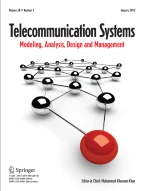Abstract
Lightweight mechanisms are included in the differentiated services architecture (diffserv) in order to provide differentiated services in the Internet. A Premium service lightweight scheme based on the delay ratio criterion with key-benefit a periodically developed conservative control mechanism is provided. Our model consists of a M/M/1/K queue for high priority (HP) packets and a finite queue birth–death (b–d) model for low priority streams. Simulation experiments under certain load and service conditions guarantee a constant delay ratio. The use of the algorithm is extended to different Home Networking Technologies (ADSL, Wireless Local Network, etc.) providing solutions to many of them.
Similar content being viewed by others
Explore related subjects
Discover the latest articles, news and stories from top researchers in related subjects.References
S. Acharya and S. Muthukrishnan, Scheduling on-demand broadcasts: New metrics and algorithms, in: MOBICOM 98, Dallas, TX, USA, 1988, pp. 43–54.
Bluetooth Technology OverView, Bluetooth SIG Web site, http://www.bluetooth.com (1999).
N. Cavies and P. Raverdy, Position paper: The role of platforms and operating systems in supporting home networks, in: ACM SIGOPS, 2000, pp. 165–170.
D. Clark and W. Fang, Explicit allocation of best effort packet delivery service, IEEE/ACM Transactions on Networking 6 (1998) 362–373.
C. Dovrolis, D. Stiliadis and P. Ramanathan, Proportional differentiated services: Delay differentiation and packet scheduling, IEEE/ACM Transactions on Networking 10 (2002) 12–26.
HomeRF, http://www.homerf.org.
T. Igarashi et al., Home network file system for home network based on IEEE-1394 technology, in: ICCE, 1999, pp. 150–151.
M. Kalia, D. Bansal and R. Shorey, Data scheduling and SAR for bluetooth MAC, in: IEEE VTC, Amsterdam, 2000, pp. 716–720.
J. Lansford and P. Bahl, The design and implementation of HomeRF: A radio frequency wireless networking standard for the connected home, Proceedings of the IEEE 88(10) (2000).
M. May, J.C. Bolot, C. Diot and A. Jean-Marie, Simple performance models of differentiated services schemes for the Internet, in: Proceedings of IEEE INFOCOM, 1999.
K. Nichols, V. Jacobson and L. Zhang, A two-bit differentiated services architecture for the Internet, Internet draft, draft-nicchols-dsopdef-00.txt (1997).
Optical Networks: Third Generation Transport Systems, Uyless Black (Prentice-Hall, Englewood Cliffs, NJ, 2002).
M. Rath et al., Novel duplexing scheme for DSL implementation, in: NCC 2002, January 2002.
T. Schoechle, HomeGate: Current issues on boadband internetworking and the residential gate-way, ISO/IEC JTC 1/SC 25/WC 1:N710, http://www.labs.bt.com/profsoc/sc25wgi/ndocs.htm (1997).
K. Shrikhande et al., Fiber to the home/desktop using Ethernet, in: OFC/IOOC'99, Vol. 2, 1999, pp. 353–355.
J. Tsiligaridis and R. Acharya, A restoration method for delay proportional differentiated services, in: Proc. of the 9th IWSSIP'02, Manchester, UK, 2002, pp. 66–70.
U. Varshney and R. Vetter, Emerging mobile and wireless networks, Communications of ACM 43(6) (2000).
W. Webb, Introduction to Wireless Local Loop (Artech House, 1998).
Author information
Authors and Affiliations
Rights and permissions
About this article
Cite this article
Tsiligaridis, J., Acharya, R. A Lightweight Scheme of Differentiated Services for Home Networking. Telecommunication Systems 23, 257–271 (2003). https://doi.org/10.1023/A:1024433709315
Issue Date:
DOI: https://doi.org/10.1023/A:1024433709315
